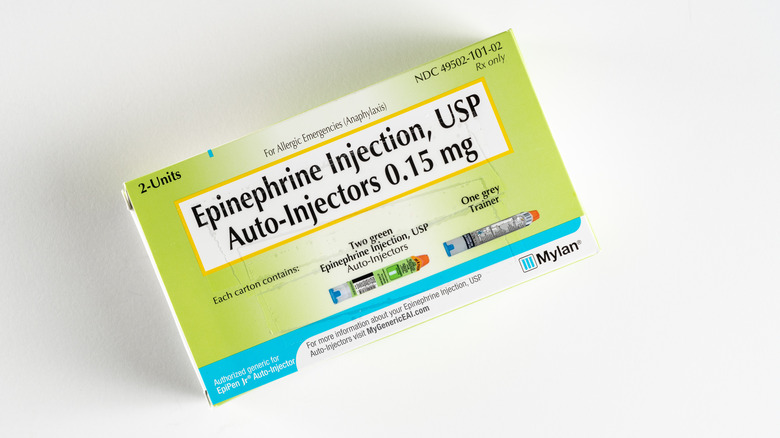Wheat Allergy: Symptoms, Triggers, And Tips
Wheat is one of the eight major allergens that must appear on food labels according to the Food and Drug Administration (FDA). But how does a person know if they have a wheat allergy? It has many of the same symptoms as celiac disease, but that is a different condition with different treatment strategies, according to the American College of Allergy, Asthma, & Immunology (ACAAI).
While a wheat allergy is most often seen in children, who may outgrow it, adults live with it as well (via Wheat Allergy). Those with this allergy can manage it by receiving an accurate diagnosis, so they know exactly what to avoid. Reading food labels is essential, but that isn't as simple as it may seem. FDA-mandated food labels may not disclose potential cross-contamination in production facilities (per FDA). There is also no rule about disclosing the presence of wheat in non-food products, leaving people with wheat allergy vulnerable to coming into contact with an item that may cause a mild or even life-threatening reaction (via ACAAI). However, learning more about wheat allergy is the first step to effective management.
What grains can you eat with a wheat allergy?
People with a wheat allergy may experience confusion about what foods they can eat and which they must avoid. This is understandable, since wheat can get confused with all grains (via Healthline). Some people may avoid more foods than they need to in order to prevent a distressing and potentially life-threatening allergic reaction.
The good news is that while wheat is a grain, not all grains are wheat. According to the U.S. Department of Agriculture (USDA), the grains food group contains food made from rice, oats, barley, cornmeal, wheat, and other cereal grains. The USDA further divides grains into two subgroups: whole grains and refined grains. Whole grains contain all parts of the grain kernel: the bran, germ, and endosperm. Refined grains have the bran and germ removed during manufacturing.
For someone with a wheat allergy, both refined wheat and whole grain wheat can cause an allergic reaction, because wheat allergy is the body's reaction to the proteins in wheat, according to Food Allergy Research and Education (FARE). That said, there are many other grains people with wheat allergy can enjoy, including rice, quinoa, millet, and flax (via Mayo Clinic). According to WebMD, rice flour, potato starch flour, and corn flour are all safe to use in baking.
Some surprising foods and non-food items contain wheat
Many people think of one food when they consider wheat allergy: bread. That's a smart intuition, as many breads contain wheat (via Healthline). Many, however, are actually made with wheat alternatives and may be safe for people with a wheat allergy (via Medical News Today).
Aside from bread, some surprising food and non-food items may contain wheat, and therefore are not safe for people with a wheat allergy. According to the Asthma and Allergy Foundation of America, wheat may be present in tabbouleh, seitan, farro, matzo, and spelt. Some of the less obvious sources of wheat are some food additives. Glucose syrup, soy sauce, textured vegetable protein, and monosodium glutamate (MSG) may all cause a reaction in people with wheat allergy. Even if wheat is not a food ingredient, people may have wheat exposure due to cross-contamination during manufacturing (via Cleveland Clinic). That's when the equipment used to make a food or non-food product is contaminated with wheat proteins, possibly transferring those proteins to other products that don't themselves contain wheat.
Non-food items can also contain wheat. Play-Doh, the children's craft item, contains wheat and can be dangerous for kids and adults that have wheat allergy. Some types of makeup can also have wheat. Since these products are not food, manufacturers don't have to declare the presence of wheat and other allergens on the labels. For this reason, people with a wheat allergy may have to be extra vigilant, as they may experience a reaction not just from eating wheat but inhaling or touching wheat products.
How common are wheat allergies?
Researchers don't know exactly how many people have a wheat allergy. It is possible many people who are allergic to wheat do not know they are, or have never received a formal diagnosis. There are estimates that between 0.2% and 1% of people have this condition (via Wheat Allergy). More kids than adults live with wheat allergy, and most kids outgrow it. As many as 65% of children who have a wheat allergy when they are young will no longer be allergic by the time they reach the age of 12. Children are more likely to develop an allergy to wheat if they do not eat this particular grain until after the age of 6 months.
Wheat allergy is sometimes confused with celiac disease, a digestive and immune condition. According to the National Institute of Diabetes and Digestive and Kidney Diseases, about 2 million people in the U.S. are thought to have celiac disease, which is often undiagnosed. About 1% of people worldwide have celiac disease.
Wheat allergy, gluten intolerance, and celiac disease
People often confuse wheat allergy with gluten intolerance or celiac disease. These are all different conditions. According to the ACAAI, people often use the phrase "gluten allergy," but this is misleading. Celiac disease is not an allergy, and there is no such thing as a gluten allergy.
Gluten intolerance can cause symptoms like diarrhea, constipation, bloating, and abdominal pain after eating gluten. Unlike celiac disease, the condition does not damage the gastrointestinal tract. The symptoms of gluten intolerance are less severe than for celiac disease (via Medical News Today). Someone with a wheat allergy can usually eat foods that do not contain wheat but may contain gluten. This is true for most people with wheat allergy, but the ACAAI recommends speaking with an allergist to see if you need only to avoid wheat or if you must stay away from other grains as well.
In contrast, someone with celiac disease has to avoid all sources of gluten, which, according to the National Institute of Diabetes and Digestive and Kidney Diseases, includes other grains such as barley and rye. Symptoms of celiac disease can include severe diarrhea, rash, severe weight loss, and abdominal pain (via ACAAI). Some people may have gluten intolerance and have to be tested for celiac disease. According to ACAAI, few people with gluten intolerance actually have celiac disease, and having gluten intolerance is not the same as having an allergy.
Symptoms of wheat allergies
Wheat allergies can cause a number of different symptoms. According to the Cleveland Clinic, symptoms may show up as soon as a few minutes to a few hours after eating or inhaling wheat, but can take as long as two days to appear.
Symptoms that happen soon after eating or inhaling wheat may include swelling or itching of the mouth or throat, hives, itchy rash, headache, problems breathing, nasal congestion, diarrhea, cramps, nausea, or vomiting (via Mayo Clinic). Some people may also experience anaphylaxis. This reaction has its own set of symptoms that indicate a potentially life-threatening situation. These symptoms include tightness of the throat, chest pain, difficulty breathing, trouble swallowing, dizziness, fainting, and pale or blue skin. Anaphylaxis may happen soon after wheat exposure. In some people, it may only occur if they exercise within a few hours of eating wheat. The Mayo Clinic calls this wheat-dependent, exercise-induced anaphylaxis.
According to the ACAAI, some symptoms of wheat allergy like stomach cramps, diarrhea, and gastrointestinal discomfort are also signs of celiac disease. It is therefore important to get the right diagnosis.
Causes of wheat allergies
According to Stanford Medicine, wheat allergy is caused by an immune system reaction. Unlike celiac disease, however, it is not an autoimmune disorder and does not cause damage to the cells of the intestine. A wheat allergy is comparable to a peanut allergy, as the biological mechanisms for both are similar. In general, an allergic reaction happens when the body encounters an allergen (via MedlinePlus). An allergen is something the body recognizes as dangerous. The immune system creates antibodies to fight the allergen, and these antibodies lead to allergy symptoms.
People with wheat allergy may have developed an allergy to one or more of the proteins found in wheat. These proteins are albumin, globulin, gliadin and gluten (via Mayo Clinic). When a person is exposed to any of the proteins they are allergic to, their body responds with an allergic reaction.
Surprisingly, some people develop a wheat allergy after repeated exposure to wheat proteins. Stanford Medicine calls this "baker's asthma," a condition experienced by approximately 4-25% of bakery workers. This happens after continued inhalation of wheat proteins and ongoing skin contact with these allergens.
Types of reactions if you have a wheat allergy
Wheat allergy is called by some sources, such as Stanford Medicine, an immunoglobulin E mediated reaction (IgE). However, other sources such as Cleveland Clinic say it is possible to have an immunoglobulin E mediated reaction (IgE) or a non-immunoglobulin E mediated reaction (non-IgE) if a person has a wheat allergy.
IgE and non-IgE are two types of food allergies. IgE allergies involve the body's IgE antibodies, while non-IgE allergies involve other parts of the body's immune system (via The Royal Children's Hospital Melbourne). Academic research says non-IgE mediated food hypersensitivity encompasses a wide range of conditions affecting the gastrointestinal tract, including celiac disease.
One of the main differences between IgE and non-IgE reactions is the time frame in which they occur. IgE symptoms happen within minutes to hours after exposure to the allergen and can include skin redness, hives, and sometimes anaphylaxis. In contrast, symptoms of non-IgE reactions include vomiting, diarrhea, and bloating, but may take hours or days to appear. For this reason, those who experience a non-IgE reaction may struggle to identify the source of their symptoms, since they may have consumed or come into contact with the offending allergen days before showing an allergic response. So, it's important to be aware that this kind of reaction is a possibility for those with wheat allergy.
Diagnosis of wheat allergy
An allergist can diagnose a wheat allergy using one of several tests (via Mayo Clinic). Typically, a doctor will start by taking a detailed medical history, including prior reactions to food. They may ask the person with the suspected wheat allergy to keep a food diary where they document exactly what they eat and what symptoms they experience. Another option for food allergy testing is the food elimination method, where foods are taken out of the diet and gradually re-introduced. As the person begins to eat certain foods again, they will note if symptoms come back.
In addition to these techniques, an allergist can perform specific tests to diagnose an allergy to wheat or another substance (via Children's Hospital of Philadelphia). Allergy skin testing is when a small sample of the allergen, such as wheat, is placed on the skin. The doctor monitors for any reaction. Allergy blood testing is when blood is drawn and screened for specific antibodies that may be produced because of a food allergy. Food challenge testing is when the person eats a small amount of the food under medical supervision, and the professional team monitors for and records any reaction.
Receiving the correct diagnosis of wheat allergy is important to distinguish symptoms caused by other conditions, such as celiac disease or gluten sensitivity.
Management of wheat allergy
Managing a wheat allergy starts by getting the right diagnosis (via WebMD). Once someone knows they are allergic to wheat and do not have celiac disease or gluten sensitivity, they can start to make safe food choices. Their doctor can also determine whether they need to avoid only wheat or other types of grains as well. Once a person's allergens are determined, it is important to not eat, touch, or inhale those allergens. For people with wheat allergy, that means avoiding foods that contain or might contain wheat or have been processed in a facility that makes or uses wheat products.
FARE notes that U.S. law mandates that eight major allergens be listed on product labels. Wheat is one of those eight allergens. It may appear in the ingredient list, after the word "contains," or in parentheses after a less-common form of the allergen. A note of caution, however. Someone with a wheat allergy cannot rely on the law to protect them from cross-contamination. Although it is common to see phrases like "may contain" and "produced in a facility" on product labels, these are voluntary declarations (via FDA). Manufacturers are not required to let consumers know whenever there's a chance the product has come into contact with a major allergen such as wheat.
Treatment of wheat allergy
Even the most diligent of people with a wheat allergy may sometimes come into contact with wheat. There are a number of ways to treat the allergic reaction to wheat, depending on the severity of symptoms. Mild symptoms are often managed with antihistamines or corticosteroids (via Cleveland Clinic).
For those who might experience anaphylaxis, it is critical to have quick and easy access to epinephrine (via Stanford Medicine). This is most commonly available by prescription in an auto-injector form. People who have an epinephrine auto-injector and their caregivers should know where it is kept at all times and instructions for proper use in the case of a severe allergic reaction.
There are promising new therapies that may offer new ways of treating, and perhaps eliminating, wheat allergies. Immunotherapy is one technique currently under study for the treatment of wheat allergies, although it is still experimental and not FDA-approved. Some research has shown that immunotherapy, where a person is given small amounts of an allergen in a controlled setting over time, can help reduce or eliminate wheat allergy (via American Academy of Allergy, Asthma, & Immunology (AAAAI)).
Tips for dining out when you have a wheat allergy
Dining out is a source of enjoyment for many people. Someone living with a wheat allergy can also enjoy this time to share a meal with family and friends, if they take certain precautions.
Start by considering the venue and whether it poses a high risk for exposure to wheat (via FARE). Think about the way food is prepared and served, to take into account the potential for cross-contamination as well as ingredients. Buffets and bakeries might be problematic. Restaurants with pre-made foods might not have a complete ingredient list, so it may be hard to know what items contain wheat. FARE has a chef card to help people communicate their food allergies to restaurant staff. People can also call the restaurant beforehand and ask about staff training, food preparation procedures, and availability of ingredient labels (via FARE). Anyone who has a great experience at a restaurant should be sure to thank the staff for the conscientiousness and understanding.
Even if all precautions are taken, it is still essential to bring at least two epinephrine auto-injectors and to make sure someone in the party besides the person with the allergy knows how to use them (via Johns Hopkins Medicine). A medical alert bracelet or necklace with information about the wheat allergy is also a good idea.












